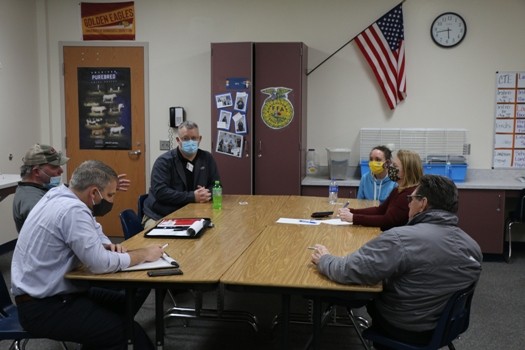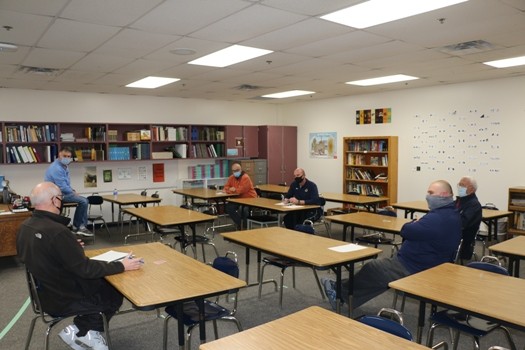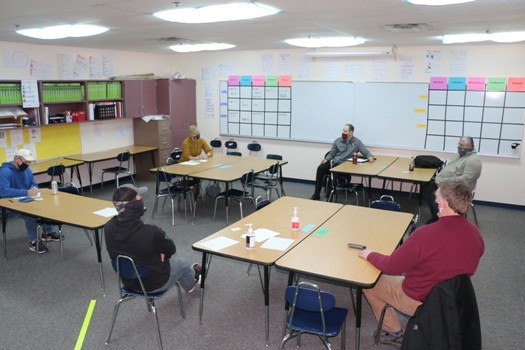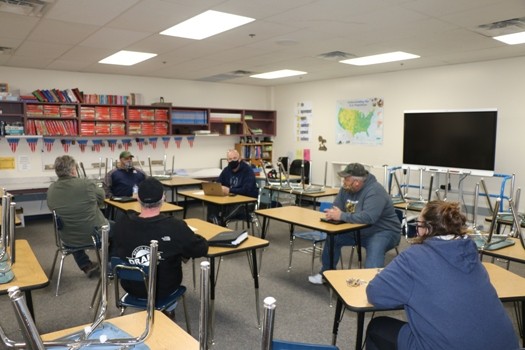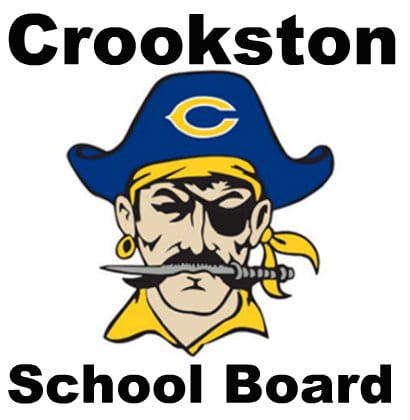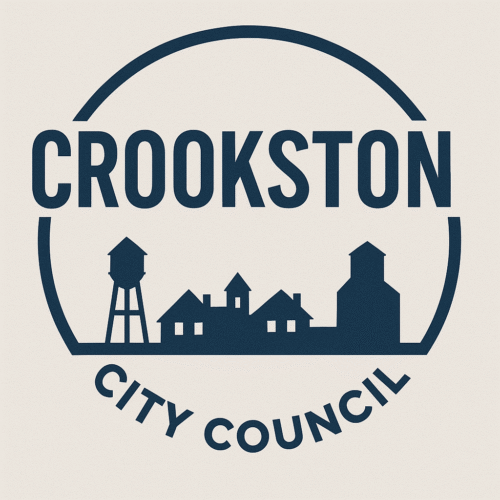A special facility committee met Wednesday at the Crookston High School to discuss building an athletic complex for the Crookston School District, including a track and football/soccer field and other amenities. The School Board had tasked Superintendent Jeremy Olson with creating a committee back in December (here), and 25 teachers, staff, business owners, community leaders, and parents attended the first meeting.
Olson said the task for the meeting was to look at a broad picture of what the community would want and support. “I was very pleased by the participation of our community members,” said Olson. “They really stepped up in a big way, came together, and talked about what do we want to see in Crookston. What is it the community wants, and what is the community willing to support? We did a small group breakout where we had small groups talking about those topics, and we brought it back into a large group for some good conversation.”
There were several consistent discussions among the various breakout groups, including the desire for a turf field capable of hosting section and state playoff games and being a multi-use facility for Phy. Ed. classes, band practice, community events, and more; an 8-lane track to be eligible to host section track meets; concessions; lights; having a field that showcased Crookston’s pride and legacy; a facility that had the amenities people look for to help retain or draw families.
The lack of a usable track in Crookston has impact impacted Crookston as a whole. Boys Track Coach Wayne Folkers said at least 20 track meets had been lost over the last five or six years. “I think right around five years ago we were going to host sections,” said Folkers. “And then, when we went out to the track and were looking at it, we had several cracks in the track. We had some spots that were broke off. You looked underneath the high jump area, that part of the track you could actually pick up and look at the asphalt underneath it. Since that time, we’ve lost two varsity meets per year that we’ve been running over at East Grand Forks and one junior high meet per year, which we’re running over at East Grand Forks as well. That’s the potential of 15 track meets that we’ve lost, and that’s not even including sub-sections and sections. We lost five sections for sure, and I think we’d have lost one sub-section since that time.”
Folkers continued that those events can bring thousands of participants and spectators to town that visit local businesses. “Looking at how many people those bring in, our big track meets, we’d have 18 teams,” said Folkers. “Our smaller track meet would have 13 teams, and then you times that by, oh 100, and we’re bringing in a lot of kids that are running on our track. And then you bring in parents, grandparents, brothers, and sisters. They’re going to McDonald’s, downtown, Walmart, Hugo’s, whatever we have available around here, they are going there. RBJ’s, I could keep going through all of the places that they visit. It’s made an impact not only on the track program, but I think it’s made an impact within the community.”
Drafts owner Brent Melsa also attended the meeting and said having a multi-use facility would impact his business throughout the year. “I think it would make a huge impact on our business,” said Melsa. “We built in 2013, and I remember track meets at UMC. There were 20-30 teams that would come to town. We got a lot of business from those, not to mention football. We got a lot of people in at Drafts from that. I think this is huge for the high school and for Crookston.”
B&E Meats owner Brent Epema also said that hosting events drives business in the community adding his belief it’s time for a facility that provides an opportunity for youth and benefits the community. “The biggest thing that I believe in is we need an opportunity for our children,” said Epema. “We need a reason for them to come here. I raised four kids that played through sports here. My dad played. My brother played, and we all shared the same facilities back in the day. Now that we don’t have the facilities people don’t want to stay. There is no reason to stay here and have your kids stay here and open a business like I did. I supply Brent (Melsa) with burgers. He gets busier; I get busier. It brings people into town, and they do their shopping. They go to my store. They go to every store and with track meets they have time to waste, so they’re going shopping everywhere. Football brings people out in droves, especially when you own it instead of being out at UMC. It was very nice that we had the contract with them, and they were there for us. But now, I feel it needs to be our own. We need to own it and have it our own.”
Activities Director Greg Garmen said he was in favor of a turf facility and that he’s had conversations with the Moorhead Activities Director (Dean Haugo) about their turf facility, and it gets used from 6 a.m.-10 p.m. when open. School Board member Frank Fee said he believes the school board would favor building a facility behind the high school over any other property if a recommendation came from the group. Alan Dragseth said he believes the state’s Ag2School tax credit for farmers on school referendums, which will reach 70 percent in 2023, would play an important role in the success of a facility referendum.
Dragseth noted that before the expanded tax credit, agricultural properties were often responsible for about 65% of a referendum even though the farmers on those properties were only about 10% of a district population. That figure closely resembles the figures on property tax wealth from the Minnesota Rural Education Association (here) on the Ag2School tax credit, “Agriculture land values still greatly impact who pays for facilities in rural Minnesota: 20 percent of districts have at least 75 percent of their net tax property wealth in agriculture land, and one-third have 50 percent in ag land.”
Lukas Biermaier said he thought it would be important during the meetings to identify the needs of a facility versus the wants, with only 20-40 percent of the school population involved in sports and not many people in the broader community being involved with the high school. And Chris Bruggeman asked what the last failed referendum for an athletic complex in 2017 was projected to cost, which was $3.105 million, and cautioned that construction costs have greatly increased in the time since that proposal.
Crookston City Administrator Amy Finch added that in speaking with the City Council, community, and industry partners, Crookston is not growing the number of families. Adding it has been expressed since her arrival last fall that a desire to grow families and expand the student base had been expressed to her consistently, and she thought that a facility like what was being discussed would a great way to do that.
Olson said he’ll start investigating the cost of topics discussed Wednesday to share with the committee before their next meeting at the end of the month. “The next steps now are to do some investigation regarding the topics brought up, put dollar amounts to those items, and bring that back to the group to start talking about what the scope of this project is going to look like,” said Olson. “March 31 at 5 p.m. in the CHS media center, we’re going to have our second round of meetings. Again, as we try to narrow the scope on what is it that this looks like, what is it that the community wants, and where do we go from here?”


